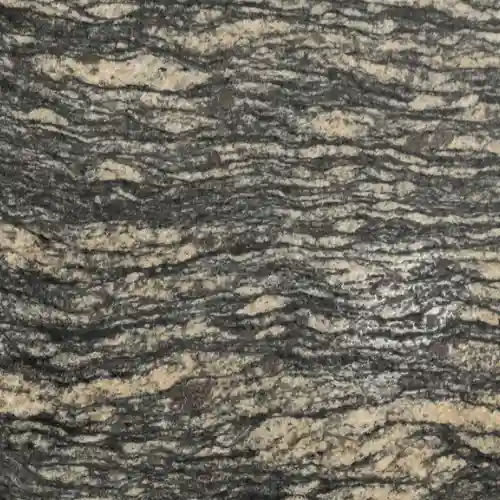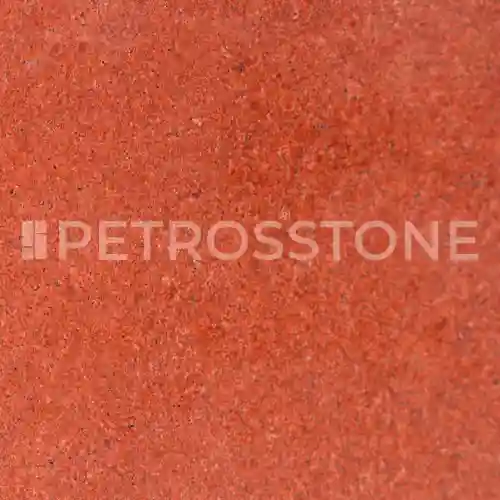
Are you a granite importer who needs safe loading and unloading of granite slabs from containers? Whether you are handling full granite slabs for the first time or are an experienced hand, understanding the right techniques is important for every supplier because loading and unloading granite can be problematic.
This guide will tell you how to load and unload the granite in a container without any damage.
- How to Load and Unload Granite in a Container?
- Loading Granite Slabs into Containers
- Unloading Granite Slabs from Containers
- Manually Unloading Containers for Small Granite Slabs
- Special Equipment Required to Unload Granite Pallets – Forklift Attachments
- A-Frames vs. Wooden Pallets – Which is better?
- Key Steps of Loading and Unloading the Granite Slabs
- Safety Precautions & Best Practices
- How to Maximize Container Stuffing? (Reduce Cost)
- What Should You Never Do When Loading or Unloading Granite in a Container?
- Need More Help? Connect with Experts Directly!

How to Load and Unload Granite in a Container?
Moving granite slabs in and out of shipping containers takes attentive planning and the right tools to keep workers safe and prevent damage. This section walks you through the process step by step, making it trouble-free for stone suppliers and manufacturers to handle slabs properly.
Choose the Best-Quality Container
1. Closed-Top Containers: These are completely sealed containers with no special areas for unloading.

2. Closed-Top Containers with Unloading Docks: These containers are also sealed but have special loading areas.
3. Open-Top Containers: Open-top containers have an open top, making it easy to remove slabs.
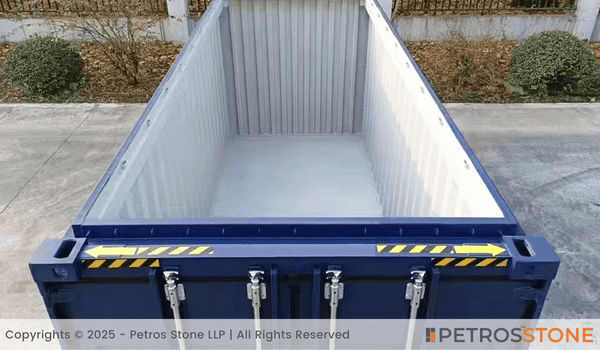
Understand How Granite Slabs Are Packed
Thinking about how granite is packaged in the container? Granite slabs, which are big, heavy pieces of stone, are packed in two main ways to keep them safe during shipping.

Wooden Bundles: Think of stacking heavy books on a shelf. That’s how granite slabs are placed – stacked together with wooden supports. Each bundle can weigh up to 3.5 tons (as heavy as a small car.)
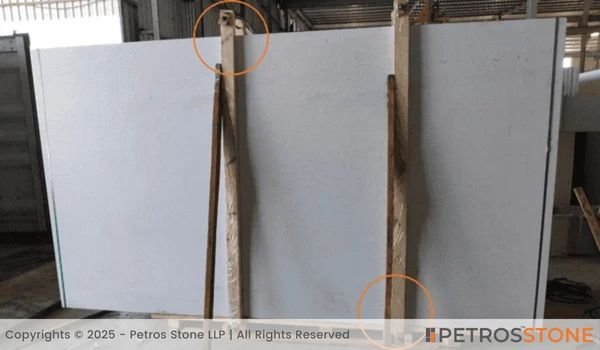
A-Frame Packing: This method looks a bit like an A-frame house! The granite slabs are placed on special stands called A-frames. This way, it is easier to lift them off and put them wherever they need to go. It allows workers to grab the slabs without struggling too much.

Loading Granite Slabs into Containers
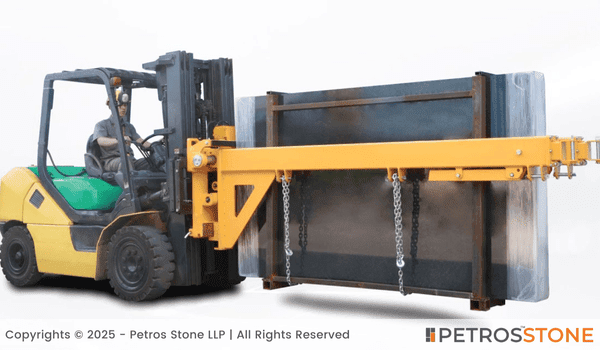
At the time of loading of granite for the shipment, you need to take different steps for both kinds of packaging, which are as follows:
Wooden Bundles
First up, we use a forklift, which is a big and strong machine with an arm that can lift heavy things. This special long arm, called an extended boom, helps it reach deep into the container. The person driving the forklift carefully lifts the wooden bundles of granite slabs and positions them inside the container. It is super important to place the bundles evenly, like balancing blocks, so they don’t tip over or shift while they are being transported.
For A-Frame Packing
For this, the workers place the granite slabs onto those special stands that look like the letter “A.” When loading these into the container, they make sure to fasten everything securely. This keeps the slabs from moving around, just like buckling your seatbelt, and keeps you safe in a car.
Unloading Granite Slabs from Containers

When your truck arrives, check your container type. Follow the right unloading method and move the slabs safely.
Closed-Top Containers without Unloading Docks
For closed-top containers, use a heavy-duty forklift. This can lift really heavy things all at once. The forklift carefully lifts the entire bundle of granite slabs out of the container. It is super important to keep the bundle stable to avoid any damage.
Closed-Top Containers with Unloading Docks
For this type of container, we use a standard forklift, which is still pretty strong but might be a little smaller. The forklift can reach high enough and is strong enough to handle the weight of the bundle. It slides the bundle out of the container.
Open-Top Containers
With open-top containers, use an overhead crane. It works like a giant arm that lifts the slabs out easily from above. The best part? It’s much safer since no one has to climb inside the container.
Manually Unloading Containers for Small Granite Slabs
Some light slabs can be carried by hand. However, this manual work requires careful safety measures.
For Safe Handling:
- Wear thick gloves – For your hands protection, wear a pair of comfortable and thick gloves while working with granite slabs.
- Use steel-toe boots – Wear steel- toe boots to protect your feet from falling slabs.
- Always wear a hard hat – Prevents head injuries from falling objects.
- Work with a partner – Makes lifting easier and safer.
- Clear the work area – Remove tripping hazards before starting.
- Create a clear path – Before starting, tidy up the space around the container. This helps prevent trips or accidents by creating a clear path.

Check the Load
- Ensure the granite slabs are checked to see whether they are cracked or not.
- Also, make sure they aren’t packed tightly together, as that could make things harder when unloading.
Team Up for Lifting Correctly
- Granite slabs can be really heavy, so always work with a partner.
- Bend your knees, not your back, to avoid hurting yourself.
- Keep the slab close to your body as you lift.
- Keep your body straight when lifting; do not twist. Move smoothly with your partner.
Move the Slabs Safely
- Grip the slab firmly with your partner.
- Keep it close to your body as you walk.
- Check for tripping hazards as you go.
- Lower it slowly into place.
Handling Bundled or Stacked Slabs
- Lifting single slabs from a tight stack is risky. Use the equipment to move the whole bundle at once.
- Once the whole bundle is outside the container, you can start safely separating the slabs with your partner’s help and move them manually.
Special Equipment Required to Unload Granite Pallets – Forklift Attachments

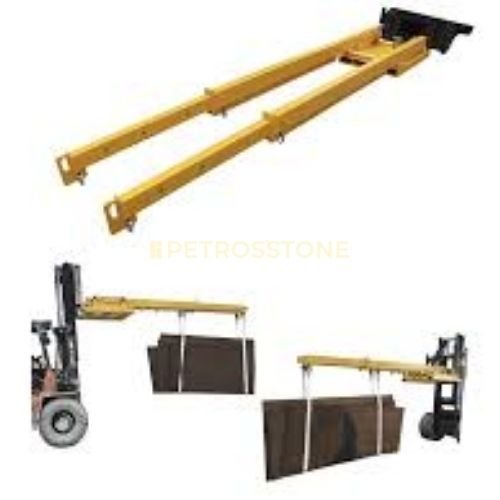
Not all the Granite slabs can be handled manually because they are quite heavy. So it is important to use the right equipment to unload them safely. Forklifts with special tools make the job easier and safer. Here are the main attachments you will need:
- Side Boom Extensions: These are long parts that are attached to a forklift. They let the forklift reach deep into containers to grab slabs without needing to get too close.
- Clamps: Clamps are strong devices that grip the slabs tightly. They keep the slabs secure without leaving marks or cracks.
- Vacuum Lifters: Vacuum lifters hold slabs by picking and holding up through air suction without holding them.
- Forklift with Extended Forks: This is a forklift with longer forks that can easily reach into containers and make it easier to lift heavy slabs.
- Pallet Forks: Pallet forks are special forks that help wooden pallets to lift and move them. They help lift the slabs off the ground quickly as well as safely.
- Lifting Beams: Lifting beams are also strong attachments for a forklift. They allow you to lift multiple slabs at once without tipping or unbalancing them.
A-Frames vs. Wooden Pallets – Which is better?


Both A-frames and wooden pallets are commonly used to pack and transport granite slabs. But which one should you choose? Let’s compare:
| Factor | A-Frames | Wooden Pallets |
| Safety | A-frames are safer. They hold slabs at an angle so they won’t fall. This makes unloading easier and safer for workers. | Wooden pallets are less protected than A-frames. While they work for lighter loads, slabs stacked on wooden pallets might move during transportation and cause damage or accidents. |
| Cost | A-frames cost more than wooden pallets, but they last longer and are safer, which makes them a good and long-term investment. | Wooden pallets are much cheaper and are a great option for smaller shipments or when budget is a primary concern. |
| When to Use | Use A-frames when transporting larger slabs or slabs that need extra support. They are very useful for slabs that are odd-sized because the A- A-Frame holds them firmly and makes unloading very easy. | Wooden pallets can be used to transport smaller granite slabs that are less inclined to shifting. They are best for smaller loads or less delicate shipments. |
Key Steps of Loading and Unloading the Granite Slabs
Loading Process
- Inspect the Equipment: Before you start, check your forklift, crane and any other equipment to make sure everything works fine.
- Position the Slabs in the Containers: Use a forklift or A-frame to place the granite slabs into the container carefully. Don’t do this job alone.
- Stack them properly: Ensure the slabs are stacked evenly, with space between them for ventilation and padding.
- Tie Down the Slabs: Use straps and tie down the slabs in a way that they don’t shift around.
- Place the Containers in the Trucks: After storing the slabs, use machines to safely load containers in the trucks.

Unloading Process
- Clear the Area: At first, when the vehicle reached there make sure the unloading area is clear of hurdles.
- Lift with Care: If the slabs are small, you can lift them manually with the help of your team. But if they are large, you must use the necessary equipment. When using a forklift, gently lift the entire bundle from the container. And if you are using a crane, position the lifting hook carefully over the granite bundle.
- Set the Slabs Down: Place the slabs on the ground or a designated storage area gently.
- Remove the Tie-downs: Once the slabs are in position, remove the straps and any padding material.
- Inspect the Slabs: Finally, inspect the slabs for any damage during the process.
Safety Precautions & Best Practices
When you handle these heavy slabs, it is important to consider everyone’s safety. Here are some points that you must keep in mind when loading or unloading:
1. Equipment Inspection: You must always check the machines, like forklifts and cranes, to make sure they are working well. It is as important as checking your bike’s brakes before riding!
2. Personal Protective Equipment (PPE): Everyone should wear the right safety gear, like helmets, gloves, and steel-toed boots. This gear helps protect you from accidents, just like wearing a seatbelt in a car keeps you safe.
3. Training: Training should be introduced on how to use equipment safely and also to load or unload properly.
4. Clear Communication: Good communication is very important between workers. It is necessary to talk clearly while working with each other. It helps keeping things very smooth and clean.
5. Sequential Unloading: First of all, remove bundles from first, then middle and after the last side while taking out slabs.
6. Use of Straps: You must secure the bundles with straps when unloading. This keeps them from falling and causing any major accidents.
7. Avoid Manual Handling: Never try to lift slabs one by one from a bundle inside the container. Always take out the whole bundle at once with the help of tools to stay safe.

How to Maximize Container Stuffing? (Reduce Cost)


Maximizing container loading is essential for optimizing shipping costs and ensuring the safe transport of granite slabs. Here’s how to achieve efficient loading:
Weight Limitations: A regular 20-foot container can hold about 6 to 8 bundles of granite slabs. But the amount you can load really depends on how heavy the bundles are and the shipping rules for the road.
Volume Considerations: Granite slabs come bundled up and each bundle have about 5 to 7 slabs inside. How many slabs fit in the container also depends on how thick each slab is and how big the inside of the container is. So, thicker slabs take up more space, which means fewer bundles can fit.
Strategic Placement: Bundles of slabs should be arranged carefully to make the best use of space. This way, slabs are snugly positioned to prevent any movement during transit, much like fitting puzzle pieces together.
Use of Loading Equipment: Strong machines, like forklifts with long arms and cranes, are used to place the bundles just right. Tools like the Abaco Container Bundle Slab Loader help lift and position the slabs safely and make the job smoother.
Tie-downs and Straps: Once the bundles are placed properly, you must use the heavy-duty straps to secure them. This keeps the slabs from shifting while they are being transported. It is important to ensure these straps are tightened properly.

Padding Materials: Padding materials must be added between the bundles to absorb any bumps or shocks. This protects the slabs from getting damaged during the journey.
What Should You Never Do When Loading or Unloading Granite in a Container?
Granite in a Container?
Handling granite slabs during loading and unloading is a high-risk activity due to their substantial weight and potential for sudden movement. To ensure safety and prevent accidents, it is crucial to avoid the following common mistakes:
Avoid Using Damaged Equipment: You must always check forklifts, cranes, and other lifting tools before using them. If they are damaged or not working right, don’t use them because faulty equipment can break down and cause serious injuries.
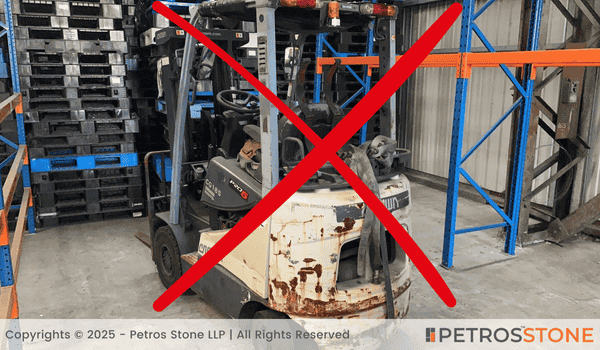
Do Not Exceed Weight Limits: Remember to be careful and do not overload storage racks. Each rack can only hold a certain amount of weight. If it’s too heavy, it can collapse, and the slabs can fall, which might hurt someone.
Do Not Skip Securing Measures: Make sure to tie down the slabs before loading or unloading. If the slabs are not tied properly or secured, they can fall, which is not safe.
Avoid Standing in the Fall Zone: You should maintain a safe distance from the place where slabs could fall from loading or unloading.
Do Not Overlook Training: Make sure that only trained workers handle the loading and unloading. Everyone should know how to do the job safely and communicate clearly during the process.
Need More Help? Connect with Experts Directly!
After reading this, you may ask: Am I able to do this job alone? Can I load and unload granite slabs myself? The answer is no—it’s not a one-person job! You need special equipment and trained professionals to do it safely. That’s where Petrosstone comes in. Our expert team handles granite loading and unloading carefully, with no damage.
For more information and options, explore our virtual directory. If you need help, feel free to contact us at:
Feel free to get in touch for a free consultation, quote, and get a detailed understanding from our experts here at Petros®. Visit https://petrosstone.com/ or call +91-8446360361 and WhatsApp

Hello!
I’m Varsha, with a deep interest in architecture and years of content writing experience, I explore how natural stones like granite and marble shape beautiful, functional spaces. At Petros® Stone, I share insights that help readers appreciate the design potential and timeless appeal of stone.
Cot Ca Gold Granite
Black Wave Polished Granite
China White Granite
Pearl White Granite
Marquina Leather Granite
Red Lakha Granite





